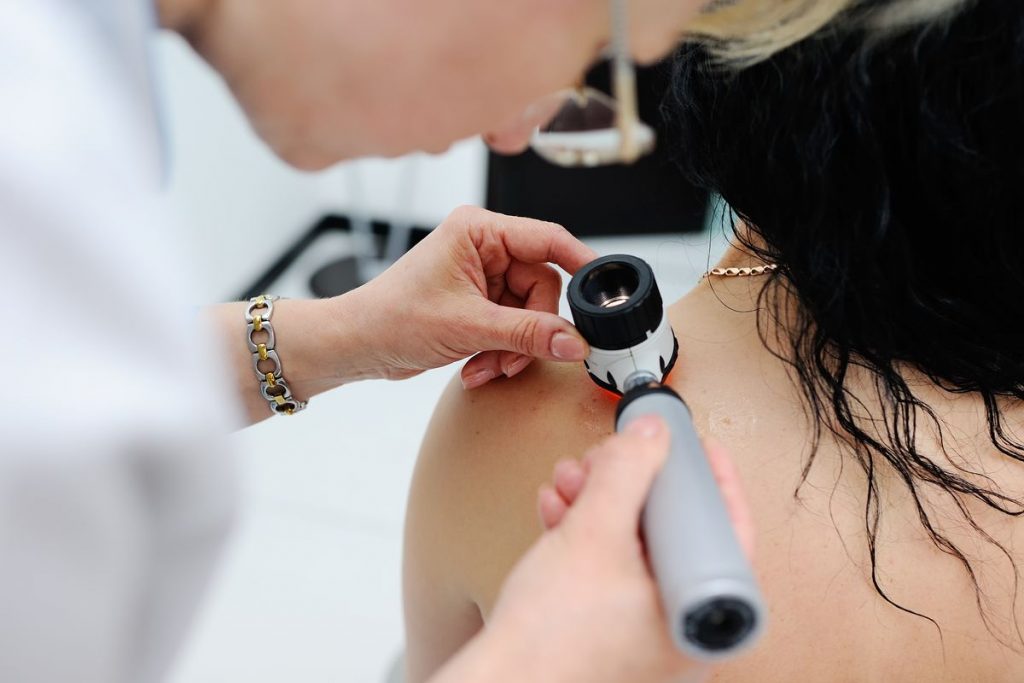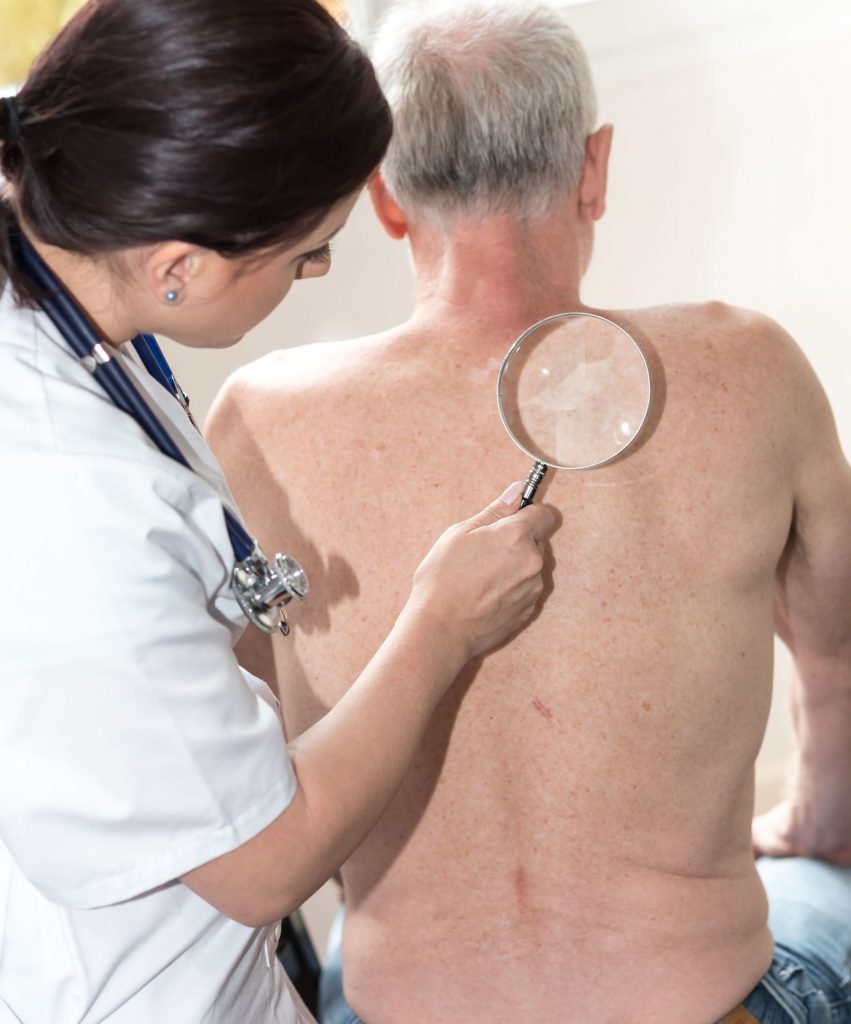What Is Skin Cancer?
Actinic keratosis, which occurs in sun-damaged skin, is the most common complaint in most dermatology practices. Mottled hyperpigmentation, freckles, superficial wrinkling, deep wrinkling, and increased superficial facial vessels on the skin are signs of sun damage. In this setting, actinic keratosis often appears as a superficial scaly area which is often rough to touch. It can be associated with hyperpigmentation, it appears insidiously and remains consistent. It can be made worse by minor trauma such as rubbing with a towel or topical treatments such as microdermabrasion, chemical peels or a vigorous facial. It is common practice to treat these lesions since 10% can progress to skin cancer.

What Are The Warning Signs?
Skin cancer can appear as a new growth or bump on the skin. The growth may be a pink scaly bump, or a waxy, scar-like, or shiny growth. It may bleed or scab without any trauma, or appear as a pimple that persists over several months. Melanoma can appear as a new mole that is growing, or in an existing mole that is changing. The ugly duckling sign is a mole that stands out and looks different from your normal moles.
Skin Cancer Types
Squamous Cell Carcinoma
This type of skin cancer is the second most common that we see in dermatologic practices. Many of these lesions arise from actinic keratoses located on sun-exposed skin. Generally, they appear as a thicker lesion that begins to grow. Occasionally, the change can be dramatic with a rapid growth of a nodular lesion. More commonly, the sun-damage keratosis grows gradually and can occasionally become a larger plaque. Often, the next change is called an area of Bowen’s disease or squamous cell carcinoma in-situ. In this case, the cancerous cells have not penetrated below the layer of the epidermis.
This can remain from days to years depending on the aggressiveness of the skin cancer. When it does progress the lesion often thickens clinically, and under microscopic examination reveals the penetration of the skin cancer from the epidermis into the dermis or deeper layers of the skin. Metastasis or internal spread is relatively rare from this type of skin cancer, especially when these occur on sun-exposed skin. Exceptions to this spread can be seen with lesions on mucous membranes such as the lips, mouth, and genital areas as well as skin cancers located on sun-protected skin.
Treatment of SCC largely depends on the stage at which the lesion is diagnosed. For in-situ lesions, cryosurgery, topical chemotherapy with 5-FU or imiquimod, and photodynamic therapy have all been used successfully.* Surgical excision is also appropriate but can be destructive.* For the more aggressive invasive lesions, excisional surgery with clear margins is ideal.* After having this type of skin cancer regular follow-up at 6-12 month intervals is ideal since recurrence and the development of new lesions remains a possibility.*

Basal Cell Carcinoma
This type of skin cancer is the most common cancer in humans. It is rarely life-threatening. More typically these lesions are slow-growing but can be a serious problem if growth occurs around areas such as the eyes, nose, and mouth. Basal cell carcinomas most likely arise from a skin cell line damaged many years ago.
Clinically these lesions appear as areas of redness that are present for months or areas where the skin becomes easily irritated and bleeds easily. Occasionally they can appear as a pearly papule or nodule. A biopsy is necessary to confirm the diagnosis. There are a number of different subtypes of BCC. The superficial type is most commonly seen on the trunk and extremities. This appears as an area of redness, which persists for many months. Microscopically the abnormal cells are seen only in the most superficial layers of the skin. This type can be treated with topical agents such as 5-FU or imiquimod as well as cryosurgery or surgical excision.* While approved in Europe, PDT is not approved in the United States. Electrodesiccation and curettage are used to treat this type of lesion but often leads to thickened scars.*
Nodular BCC is also a very common form of this, which appears as a pearly papule. Microscopically, this lesion seems to be deeper than the superficial BCC skin cancer. Surgical excision and cryosurgery can appropriately treat this type of skin cancer.* Some individuals also believe that electrodesiccation and curettage are also useful.*
Sclerosing, micronodular, and basosquamous basal cell carcinomas are much less usual varieties of this type of skin cancer. They can be more aggressive and are best treated with excisional surgery and, in some instances where margin control is difficult, Mohs surgery.* This type of surgery necessitates a surgical staff and training where the tumor can be histologically examined at the time of surgery to ensure complete removal. Mohs surgery is preferred on difficult to treat lesions on the face as well as lesions that are recurrent.* Follow-up of all types of skin cancer is important to monitor the recurrence of previously treated lesions and the development of new skin cancers, which happens more commonly in patients with past skin cancers.
Malignant Melanoma
While this is the least common of the skin cancers, it can be the most lethal. This tumor arises in a clone of abnormal pigment-producing cells called melanocytes. This can rapidly transform and spread internally through the bloodstream and lymphatic channels of the body. This type of cancer can be associated with fair-skinned individuals, who often have a history of sun burning. This can occur on its own or as a result of a mole that has become malignant.
A changing mole can be one that is asymmetric where one-half does not match the other. The borders are often irregular or notched, the color is often 2 and 3 tones. Often these lesions are 6mm or greater in diameter, which is larger than an eraser on a typical pencil. Most importantly these are lesions that are changing. Periodic self-examination or visual check by another person can be useful in spotting these mentioned features.
Histological examination and biopsies are an important part of diagnosing these lesions. When a diagnosis is made a complete excision with appropriate margins is the treatment of choice.* Topical methods of treatment and destructive methods such as cryosurgery, lasers and electrodesiccation and curettage are inappropriate. Periodic re-examination afterward is important. There are new and promising but very expensive therapies for metastatic lesions.
A less aggressive form of malignant melanoma, commonly referred to as a lentigo maligna, is seen commonly on sun-exposed areas, especially the face. Excisional surgery is best for this type of lesion.* Local recurrence is not uncommon.
Sometimes the malignant cells are seen only in the superficial layers of the skin and do not penetrate into the deeper layers. This type of lesion is commonly referred to as malignant melanoma in-situ of atypical melanocytic hyperplasia. Complete excision of this type of lesion is the treatment of choice and generally very successful in its eradication.* As with other types of cancer, appropriate follow-up is important.
Skin Cancer Treatment Options

Liquid Nitrogen Therapy
We use several therapeutic modalities to treat these lesions. The most common is liquid nitrogen therapy. This involves blotting or spraying liquid nitrogen superficially on the skin to thermally damage the abnormal cells and permit the regrowth of skin with undamaged keratinocytes.* As we age the healing process often slows substantially. It is practical to treat anywhere from 1-20 lesions.* Treating more on areas such as the face can result in significant swelling. Post-treatment care usually includes gentle bathing and the use of occlusive moisturizers such as white petrolatum or Vaseline.
Surgery
Surgical excision, also known as an excisional biopsy, is a procedure that removes cells or samples of skin from the surface of the body. During the surgery, Dr. Tanghetti will use a scalpel to remove a lump or an entire area of abnormal skin. You will receive a local anesthetic beforehand to numb the area. Stitches may be needed to close the wound and adhesive bandages will be placed over the excision to prevent bleeding and to protect the wound.
Mohs surgery is a highly specialized and precise treatment for skin cancer in which the cancer is removed in stages, one tissue layer at a time. Once a tissue layer is removed, it is examined under a microscope to check for cancerous cells. This process is repeated until the cancer cells are no longer present.
Photodynamic Therapy
Photodynamic therapy is a very convenient way to treat diffuse actinic keratosis.* This usually involves the application of a drug called levulan or metvix for 2-3 hours with subsequent light treatments with either blue or red light. It takes a number of hours for this drug to become activated.* Sun sensitivity can last up to 2 days after use of this drug. Some centers do 2- 3 treatments to obtain an adequate response.* We use pre-treatment with topical 5-FU for a number of days prior to light therapy. This allows us to highlight the otherwise invisible subclinical lesions and results in an enhanced response to treatment.*
Schedule OnlineTopical Treatments for Skin Cancer
Other treatment modalities include topical 5-FU.* This is still the most used treatment for multiple actinic keratoses. Usually, there are 20 or more lesions in a large field such as the face and scalp. Treating such a large area with liquid nitrogen is impractical. 5-FU cream is used over a 2-3 week period of time. It can result in redness of the lesions with new subclinical lesions appearing with more days of treatment.* After a 2-3 week treatment period has ended, treatment with the use of healing and moisturizing products such as white petrolatum or Vaseline with gentle bathing can promote faster incision healing.* There are rare allergic reactions to this product that typically appear as a red dermatitis in areas that do not have actinic keratosis. There are a number of products that contain this active ingredient. They include Efudex, Carac, and a generic 5-FU.
Imiquimod for Skin Cancer
Imiquimod is another agent commonly used to treat actinic keratosis.* We studied this product in a head to head manner with topical 5-FU and found it to be less efficacious.* For individuals allergic to topical 5-FU, this therapy can be used successfully, but the required amount of medicine to successfully complete treatment of a large area can often require several hundred dollars’ worth of medicine.*
Picato
Picato is also known as ingenol mebutate is a new agent that can induce an intense inflammatory response with the elimination of actinic keratosis.* This drug is used for a number of days. As this reaction can be severe a careful topical regimen of gentle cleansing followed by a moisturizer such as white petrolatum or Vaseline is helpful.* Since this is a relatively new agent long-term issues remain to be clarified.
The purpose of these treatments is to clear these precancerous lesions to prevent the progression to skin cancer.*
Request an Appointment in Sacramento, CA
Dr. Tanghetti’s work has been published in journals such as Lasers in Surgery and Medicine, Journal of Dermatologic Surgery, the Journal of Cosmetic and Laser Therapy, and Cutis. He is a fellow of the American Society for Laser Medicine and Surgery, and a member of the California Medical Association, the American Medical Association, and the American Academy of Dermatology. For a consultation to discuss the skin cancer treatments offered at our clinic, call us at [916] 454.5922 or complete the form below.
Schedule Online
"*" indicates required fields

